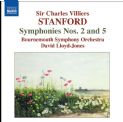Symphonies vol.2 (Naxos Audio CD)
Symphonies vol.2 (Naxos Audio CD)
Special Offer
* Estimated price converted from UK retail price
Bournemouth Symphony Orchestra
David Lloyd-Jones, conductor
“David Lloyd-Jones proves an undisruptive, clear-headed guide, while the playing of the Bournemouth SO has an extra finish, buoyancy and lustre that tip the scales in his favour.” Gramophone Magazine
“Both symphonies contain some attractive ideas, they're beautifully scored and carefully worked out, and they make enjoyable listening… David Lloyd-Jones certainly makes a strong case for both, and the excellent Bournemouth players respond with collective discipline and solo expressivity.” BBC Music Magazine, November 2007 ****
“In memoriam, Stanford's Second Symphony… wears a largely untroubled demeanour. Like Handley, David Lloyd-Jones proves an undisruptive, clear-headed guide, while the playing of the Bournemouth SO has an extra finish, buoyancy and lustre that tip the scales in his favour.” Gramophone Magazine, December 2007
“Although labelled Elegiac and prefaced with lines from Tennyson's In memoriam, Stanford's Second Symphony (1880) wears a largely untroubled demeanour. In fact, it's a thoroughly congenial, skilfully scored creation, with frequent glances of approval towards Mendelssohn, Schumann, Brahms and Dvorák, yet it received just two performances in 1882 and 1883 before falling into oblivion. Vernon Handley revived it with the Ulster Orchestra in 1990 and went on to record it a year later as part of his pioneering Stanford symphony cycle (Chandos). Like Handley, David Lloyd-Jones proves an undisruptive, clear-headed guide, while the playing of the Bournemouth SO has an extra finish, buoyancy and lustre that tip the scales in his favour.
Honours are more evenly divided in the altogether meatier Fifth Symphony of 1894, which derives its subtitle and inspiration from Milton's twinned poems L'Allegro and Il Penseroso. Lloyd- Jones's bright-eyed approach is especially effective in the first two movements (the rustic Scherzo gambols along most winningly), whereas it's Handley who better captures the more thoughtfully restrained character and inexora- ble grandeur of the work's second half. Moreover, Chandos's 1987 Ulster Hall production has the estimable advantage of an organ in situ for the symphony's heady apotheosis (its initial entry on the Naxos disc is too discreet – the sound is otherwise very pleasing). Tiny grumbles aside, Lloyd-Jones's remains a strongly recommendable pairing and should be snapped up without delay.” Gramophone Classical Music Guide, 2010







